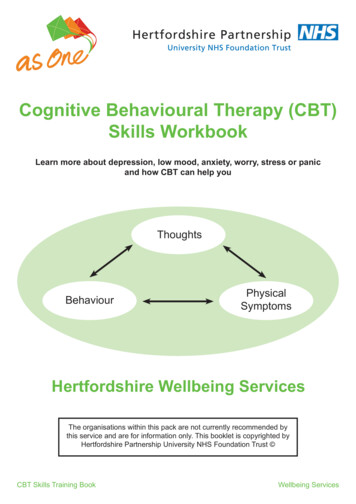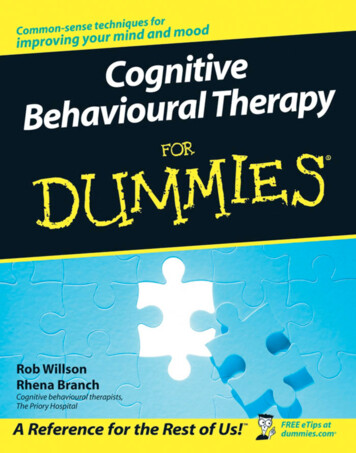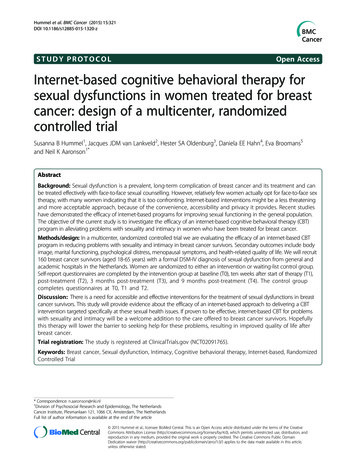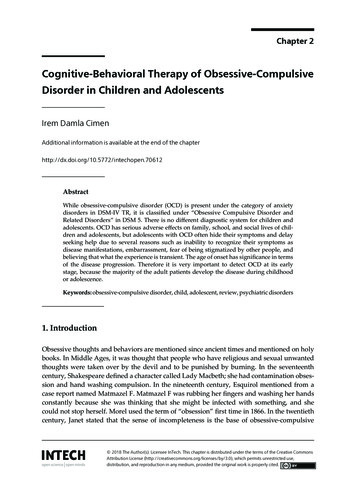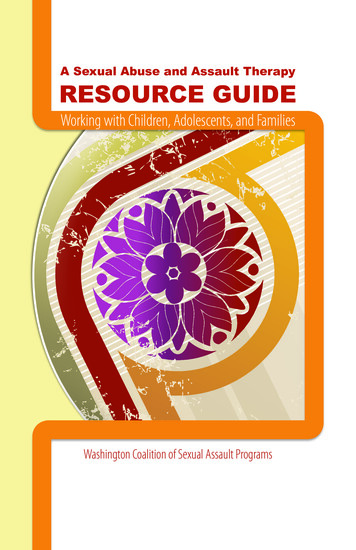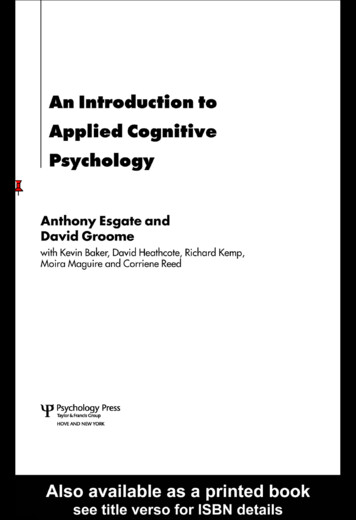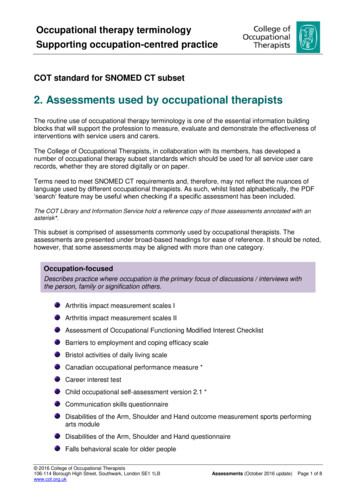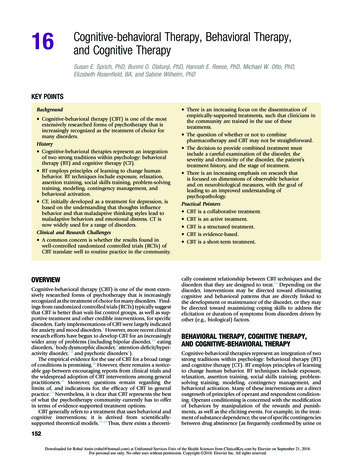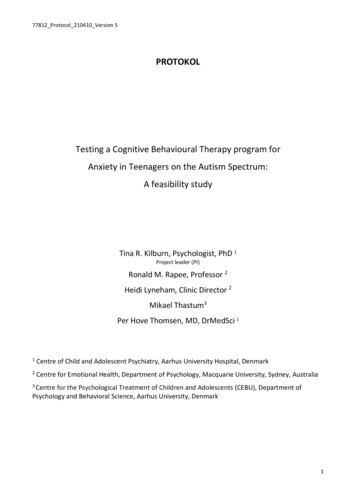
Transcription
77812 Protocol 210410 Version 5PROTOKOLTesting a Cognitive Behavioural Therapy program forAnxiety in Teenagers on the Autism Spectrum:A feasibility studyTina R. Kilburn, Psychologist, PhD 1Project leader (PI)Ronald M. Rapee, Professor 2Heidi Lyneham, Clinic Director 2Mikael Thastum3Per Hove Thomsen, MD, DrMedSci 11Centre of Child and Adolescent Psychiatry, Aarhus University Hospital, Denmark2Centre for Emotional Health, Department of Psychology, Macquarie University, Sydney, Australia3 Centrefor the Psychological Treatment of Children and Adolescents (CEBU), Department ofPsychology and Behavioral Science, Aarhus University, Denmark1
77812 Protocol 210410 Version 5ObjectivesThe primary objective is to investigate the feasibility of a newly developed manualised groupCognitive Behavioural Therapy (CBT) programme for anxiety in teenagers (aged 13-17 years) withAutism Spectrum Disorder (ASD). Our aim is to focus primarily on acceptability and compliance withthe program with some investigation of treatment effects on anxiety diagnosis and anxietysymptoms.BackgroundAutism spectrum disorders (ASD) include deviations and delays in the development of socialinteraction, communication patterns, restricted stereotyped and repetitive behaviours, and areas ofinterests (Szatmari, 2003). ASD conveys persisting negative effects on learning and development ofindependence in adulthood (Howlin, Goode, Hutton, & Rutter, 2004).The prevalence of ASD has increased markedly over the last three decades (Atladottiret al., 2015; Bertrand et al., 2001; Fombonne, 2002; Scott, Baron-Cohen, Bolton, & Brayne, 2002;Wing & Potter, 2002) and is now thought to occur in about 6 cases per 1000. The average age ofdiagnosis is around 5.3 years (Parner, Schendel, & Thorsen, 2008) but resent studies show a largeincrease in incidence rates for ASD among teenagers (Jensen, Steinhausen, & Lauritsen, 2014). Thisincrease is mainly identified for Asperger’s syndrome since higher functioning children and teenagerswith ASD are harder to identify before the beginning of adolescence where demands on socialcommunication skills, flexibility and social interaction become more complex and thus surpass theability of the young adult (Jensen et al., 2014).Approximately half of teenagers diagnosed with ASD have a relatively poor psychosocialdevelopment into adulthood (Eaves & Ho, 2008) affecting work prospects, friendships andindependence, and leaving them socially isolated and reliant on social, community and family care(Schall, Wehman, & Carr, 2014). Although outcome for adults with ASD has improved over recentyears, many remain highly dependent on others for support (Howlin et al., 2004).Co-morbid disorders in Individuals with ASD are common (Coleman, 2000; Ghaziuddin,2005) and seem to have an even greater impact on the young person’s life than the ASD itself(Coleman, 2000; Gillberg & Coleman, 1992). Thus, treatment of co-morbid disorders may potentiallyadd considerably to the improvement of quality of life, general functioning, independence anddevelopment (Ghaziuddin, 2005).Anxiety disorders (Brereton, Tonge, & Einfeld, 2006; Leyfer et al., 2006; Simonoff et al.,2
77812 Protocol 210410 Version 52008; Steinhausen & Metzke, 2004) are some of the most prominent co-morbid disorders and areestimated to occur in 11-84% of individuals with ASD (Kreslins, Robertson, & Melville, 2015). Due toa unique interaction between anxiety and core ASD symptomology, the manifestation of anxiety inindividuals with ASD differs in several ways from anxiety seen in typical developing youths. Anxietyin ASD is associated with more behavioural problems, such as social avoidance, repetitive behavioursand aggression (Kreslins et al., 2015).Cognitive Behavioural Therapy (CBT) is shown to be very effective in the treatment ofanxiety in neuro-typical children and teenagers (Higa-McMillan, Francis, Rith-Najarian, & Chorpita,2016; Reynolds, Wilson, Austin, & Hooper, 2012). Children with co-morbid ASD, however, seem torespond less favourably to standard CBT programs (Rapee, 2003) and research shows that CBTprograms specifically designed for children with ASD and co-morbid anxiety are highly efficacious intreating anxiety disorder (Chalfant, Rapee, & Carroll, 2007; Kilburn et al., 2020; Kreslins et al., 2015;Storch, Arnold, & Lewin, 2013; Sukhodolsky, Bloch, Panza, & Reichow, 2013) thereby reducing theco-morbid symptoms that otherwise untreated may lead to extra impairment in daily life skills. Themajority of this evidence, however, is from studies with younger children and, to our knowledge, nostudy has so far evaluated the efficacy of such a program specifically developed for teenagers(Perihan et al., 2019).Treatment of anxiety in teenagers with ASD is especially important since this is avulnerable time of development. The teenage years are when social relationships become mostimportant, youngsters start dating and get sexually interested, become more independent, and ideasand motivations are forming for future careers and work (Rapee et al., 2019). Autism SpectrumDisorder and co-morbid anxiety will interfere with many of these processes making this co-morbidityduring the teenage period especially critical for long-term functioning, independence and ability tobecome self-sufficient (Volkmar, Reichow, & McPartland, 2014).The CBT program aimed at younger children between 7 and 13 years of age – ‘Cool KidsASD Anxiety Program’ 2nd Ed. (Lyneham, Chalfant, Kilburn, & Rapee, 2018 (in print)) – has beenexamined in a randomized controlled trial (RCT) in a non-English-speaking general hospital setting.The study showed positive results in the efficacy and satisfaction of the program for younger childrenwith ASD and anxiety (Kilburn et al., 2020). However, this program is not suitable for teenagers abovethe age of 12-13 years and thus, the efficacy on older teenagers and young adults are uncertain.The child version – ‘Cool Kids ASD Anxiety Program’ 2nd Ed. (Lyneham et al., 2018 (inprint)) – uses hand puppets and animal cartoons and relates on full parental support. Issues dealt3
77812 Protocol 210410 Version 5with concerns mainly topics related to young children and the challenges they might face on a dailybasis.A program for older teenagers and young adults needs to target topics related to thisage group where specific age-related challenges associated with this group of young people with ASDcan be incorporated. Since social relationships are a main challenge for many young people with ASDand often courses them to withdraw from others and experience levels of social anxiety (Rapee etal., 2019), topics related to overcoming social difficulties and solving problems without close parentalassistant are important to target in such a program. Further, targeting the co-morbid anxiety needsto be approached in an age-related manor in order to enhance involvement and participation in theprogram.Since high functioning ASD is often not recognised before adolescence, the co-morbiddifficulties might not have been dealt with earlier leaving these teenagers in need of disorder- andage-appropriate treatment programs. Thus, in order to secure the best possible developmental pathsand future possibilities for teenagers with ASD, it is important that age-appropriate treatmentmanuals aimed at co-morbidities such as anxiety are developed and tested.Method/DesignIn cooperation with professor Ronald Rapee and clinic director Heidi Lyneham (the developers of theoriginal Cool Kids programs) (Lyneham, Abbott, Wignall, & Rapee, 2003), we have developed an ageappropriate version of a manualised CBT group treatment suited to treat teenagers with ASD and comorbid anxiety.The program is in the process of being edited and finalised before translation andadaptation to Danish conditions.Development of ‘Chilled ASD Anxiety Program’The ‘Cool Kids ASD Anxiety Program’ was developed at the Centre for Emotional Health, MacquarieUniversity, Australia specifically for children with ASD and co-morbid anxiety allowing for thedifficulties that children with ASD experience (Lyneham et al., 2018 (in print)). The ‘Cool Kids ASDAnxiety Program’ is aimed at children aged between 6 and 13 years and follows the original ‘Cool KidsAnxiety Program’ (Lyneham et al., 2003) but with modifications relevant to autism. The cognitivework has been simplified, 2 relaxation techniques are introduced and in-session exposure is part ofthe planning together with simplification of the material with many prepared worksheets and4
77812 Protocol 210410 Version 5pictures. Further, two hand puppets are introduced in order to visualise and externalise the anxietyissues.Using the child version of the ASD program as a template and some of the approachesin the ‘Cool Kids (Chilled) Adolescent Anxiety Program’ program for neuro-typical teenagers, the PITina R. Kilburn has in collaboration with the Centre for Emotional Health, Macquarie University,Australia developed a version (‘Chilled ASD Anxiety Program’ (working title)) aimed at individualsabove 13 years of age with ASD and co-morbid anxiety disorder. Further, in the development of the‘Chilled ASD Anxiety Program’ specific age-challenges (e.g. social difficulties, building confidence,problem solving ect.) associated with this group of young people with ASD have been incorporated.After joint editing and finalisation of the program it will be translated into Danish before being triedin the feasibility study.ProcedureStudy populationThirty teenagers aged 13-17 years with an active ASD diagnosis and experiencing life interferenceanxiety symptoms will be eligible to participate in the study. Even though we expect the program tobe beneficial for individuals older than 17 it will be more appropriate to recruit youngsters under theage of 18 (the legal age in Denmark) to enhance parents' participation.VisitationRecruitment will take place through information conveyed to general practitioners, differentRegional Centres of Child and Adolescent Psychiatry, Community Care offices, the ASD association,and through media such as newspapers, journals and the internet.After first contact the families will be contacted by the PI via email with the written informationinforming them about the project, the inclusion and exclusion criteria together with an invitation toa personal meeting conducted at a private interviewing room at the Aarhus University Hospital,Psychiatry, Department of Child and Adolescent Psychiatry, Research Unit or at the 'JointCounselling for Children and Youths' (PPR) in Frederiksberg. In the mail and in the writteninformation the right to bring an assessor at the meeting is explained. At the meeting, informalclinical screening of anxiety symptoms will be performed by way of interviewing the family abouttheir daily life and experienced challenges, further information will be given and consent formsigned by both parents with joint custody. If the young participant becomes of age (turns 18 years)5
77812 Protocol 210410 Version 5during the project time, he/she will have to sign a new personal consent form. The family is entitledto 48 hours reflection time before signing the concentform. Clinical psychologist with extensiveknowledge of the project, ASD and anxiety will convey the oral information. The young peopleparticipating in the trial will receive the same oral information and be involved in the conversationswith the parents about the trial. The young person's own statements will be given crucialimportance.The participants will receive a small token of gratitude in the form of a trip to the cinemafor the family (DKK 500,-) for completing the treatment and answering all interviews andquestionnaires throughout the project.InclusionTo be considered for enrolment into the project the teenagers will have to fulfil the diagnostic criteriafor one or more anxiety diagnoses on the Anxiety Disorders Interview Schedule for DSM-IV: Parent &Child interview schedule (ADIS C/P) (Silverman & Albano 1996).Further, a diagnosis of ASD according to the International Classification of Diseases,10th edition (ICD 10) (WHO, 2010) by a Private Psychiatric Clinic or by one of the Regional Child andAdolescent Psychiatric Centres in Denmark should have been obtained. The ASD diagnosis may notlater have been revoked by a psychiatrist. Participants will not be accepted into the project withoutaccompanying documentation of their ASD diagnosis.ExclusionExclusion criteria for entering the trial is low intellectual functioning ( 70). Assessment of cognitiveability (IQ) has often been part of the investigation regarding a possible ASD diagnosis and will, withparental consent, be retrieved from the teenager's journal. However, if assessment of IQ is missing ashort version of the Wechsler Intelligence Scale for Children (Wechsler, 2014) will be performed.Further exclusion criteria are active psychosis, untreated hyperkinetic disorder, inabilityto speak Danish, or inability to leave the home, attend a group setting, or to meet for treatmentcaused by other psychiatric disorders.InterventionThe group based manualised CBT intervention program ‘Chilled ASD Anxiety Program’ (working title)6
77812 Protocol 210410 Version 5will be used. The program will be conducted in 10 sessions over approximately 13 weeks with afurther booster session 3 months after treatment. The sessions are group based comprising fiveteenager and parent dyads and conducted weekly, with a one week break after sessions 3, 6, and 8to allow participants time to implement strategies in daily life. Each session lasts 2 hours and includestime spent working with the teenagers alone, time with the parents alone and time with parents andteenagers together. The teenager and at least one parent will attend the groups. The main grouptherapist will be a psychologist certified or well experienced in the Cool Kids programs and the cotherapist will be a psychiatric nurse, educationalist, or master class or above psychologist. Further, agraduate psychologist will be involved as a practical helper.Treatment integrity will be assed for teenager and parent dyads using questionnairesregarding number of sessions attended and homework compliance. All sessions will be videotapedand adherence to the manual will be assessed through observation of a random selection of 2sessions out of the 10 sessions (20%) for each treatment group by a therapist who has not beeninvolved in the treatment.Participants will be encouraged not to seek other forms of treatment or change possiblepsychopharmacological medication during the trial period.MeasuresFeasibilityPost-treatment teenagers and parents will be asked to complete a questionnaire adapted from TheExperience of Service Questionnaire (Attride-Sterling, 2002; Brown, Ford, Deighton, & Wolpert, 2014)measuring their satisfaction with the treatment. On a Likert scale they will be asked to rate positivestatements as 'not true' (1), 'partly true' (2), or 'true' (3) and in an open section freely comment ontheir experience with the treatment.Participant dropouts will be investigated together with the proportion of completedsessions, homework and questionnaires.Therapists will complete a qualitative survey regarding satisfaction with contents, easeof conveying program, and suitability of the program to teenagers with ASD.Following completion of the program a focus group comprising a sample of participatingteens and separately parents will be established to discuss the strengths and weaknesses of theprogram.7
77812 Protocol 210410 Version 5AnxietyDiagnosis of primary anxiety will be carried out using the Anxiety Disorders Interview Schedule forDSM-IV: Parent & Child interview schedule (ADIS/CP) (Silverman & Albano, 1996) for both teenagersand parents. ADIS/CP is a semi-structured interview with separate interviews for both teenager andparents designed to assess for current episodes of anxiety disorders, and to permit differentialdiagnosis among the anxiety disorders according to DSM-IV criteria.The disorders are rated with a clinical severity rating (CSR) from 0 (no interference) to8 (extreme interference) with severity ratings of 4 or above signifying the presence of a clinicaldisorder. The assessor's CSR score will be based on a combination of the parent and teenagers' CSRscore plus a clinical evaluation of the extent of severity. The disorder with the most impairingdiagnosis will be considered the primary anxiety diagnosis.The ADIS/CP has demonstrated good-to-excellent 7–14 days test–retest reliability forthe presence of specific anxiety diagnoses (Cohen's Kappa [κ] range for different diagnoses 0.71–0.84 for children's interviews and 0.73–0.92 for parent's interviews) (Silverman, Saavedra, & Pina,2001).The ADIS/CP assessment will be performed by trained psychology students undersupervision of a senior assessor. The interviewers will be blinded to the purpose of the study and willnot assess the same participant more than once.Additional anxiety assessments administered to teenagers and parents will be collectedby the following questionnaires using an on-line data collection platform (REDCAP).Spence Children's Anxiety Scale (SCAS) (Spence, 1998), is a questionnaire for teenagers and parentsassessing the severity of anxiety symptoms broadly in line with the dimensions of anxiety disorderproposed the DSM-IV.Children's Anxiety Life Inference Scale (CALIS) (Lyneham et al., 2013), is designed to assess lifeinterference attributed to fears and worries from teenager and parent perspectives. The measuretargets interference with the teenager's life and with the parent's/family's life.Children's Automatic Thoughts Scale (CATS) (Schniering & Rapee, 2002), is a developmentallysensitive, general measure of negative self-statements across both internalizing and externalizingproblems. Four separate subscales of cognitive content are assessed including physical threat, socialthreat, personal failure, and hostility.8
77812 Protocol 210410 Version 5Further, indications of ADHD will be assessed using the Attention Deficit/HyperactiveDisorder-Rating Scale (ADHD-RS) (DuPaul, Power, Anastopoulos, & Reid, 1998) and Teenagers' andparent’s quality of life will, in addition, be investigated with The WHO-five Well-being Index (WHO5) (Bech, 2004).All measurements will be performed before baseline (Pre), after the intervention (Post)and at 3 months follow-up (Fu) (See Fig. 1).Finally, demographic information will be obtained by questions concerning level ofeducation, employment, household income, number of siblings etc. in addition to other backgrounddata such as previous treatment, special school attendance etc.AnalysisThis feasibility study is being conducted to assess the feasibility of the project in order to be able toscale to a bigger study. Our main aim is to learn about enrolment challenges, satisfaction of manualsand delivery of program, questionnaires and interview schedule. With this aim in mind we expectthat a study population of 30 teenagers is a reasonable sample.The satisfaction questionnaires will be analysed by calculating the percentage of 'not true', 'partlytrue', or 'true' answers for each of the questions while examples of both positive and negativecomments will be reported including reasons for possible dropouts. Percentage of participantdropouts will be calculated together with the quantity of completed sessions and questionnaires.Extent of homework completed in preparation for each session will be calculated. Comments fromtherapists' survey and the focus group will be collected and reported as qualitative data.Outcomes regarding changes in diagnostic status, severity of anxiety symptoms, lifeinterference attributed to fears and worries, and teenagers' negative self-statements measured withADIS/CP, SCAS, CALIS and CATS will be investigated. Mean scores (M) with standard deviations (SD)will be calculated Pre and Post-treatment and at FU for the above measurement followed by the useof Cohen's d for repeated measures to calculate within-group effect sizes at the different data points– pre to post-treatment and post-treatment to FU.In addition, the overall percentage of teenagers free of primary anxiety disorder andfree of all anxiety disorders will be calculated.Statistical analyses will be conducted by the use of STATA (StataCorp, 2019) and thesignificance level will be set at P value of less than 0.05.9
77812 Protocol 210410 Version 5TimelineJanuary 2021 – June 2021 Final translation and modification of treatment manual for teens, parents and therapists Request for Research Ethics Committee Notification to the Data Protection Agency Continuing funds applications Development of information materialJuly 2021 – September 2021 Training of therapists Interviewing and inclusion of patientsOctober 2021 – June 2022 Conducting feasibility study with 15 teenagers (see Fig. 1.)July 2022 – December 2022 Data analysis PublicationsCollaborationsThe project is instigated in a collaboration between Aarhus University Hospital, Psychiatry,Department of Child and Adolescent Psychiatry, Research Unit and Professor Ronald Rapee andclinic director Heidi Lyneham, Centre for Emotional Health, Macquarie University, Sydney, Australia.The existing successful cooperation with the Centre for the Psychological Treatment of Children andAdolescents (CEBU), Department of Psychology and Behavioural Science, Aarhus University, (Kilburnet al., 2020; Kilburn et al., 2018, 2019) is extended by agreement with Professor Mikael Thastum toinclude the above project.Part of the intervention (approx. 3 additional groups) will take place at the 'Joint Counselling forChildren and Youths' (PPR) in Frederiksberg. The recruiting, inclusion and data collection will be asdescribed above and the therapist undertaking the treatment will be trained by the PI.Plan for disseminationAll results, positive, negative or inconclusive, will be published in international, peer-reviewedpsychiatric or psychological journals and be presented at relevant international conferences. National10
77812 Protocol 210410 Version 5interest associations, social medias and national media outlets will be informed together with DanishRegions and Local Authorities in order to update knowledge and enhance implementation. If themanualised treatment program appears beneficial the material will be available for purchase byprofessionals at CEBU, Department of Psychology and Behavioural Science, Aarhus Universitycontaining the names of the funding contributors.Legal and financial aspectsMacquarie University will have copyright of the program abroad and a license to print and distributethe Danish version will be bestowed CEBU, Department of Psychology and Behavioural Science,Aarhus University who holds the sole Danish rights to other Danish Cool Kids treatment versions.The study is funded by the TRYG Foundation with 999.664 DKK over a 2-year period. The funding willbe used for remuneration of staff, materials, compensation, publication etc. and is payed to andadministrated by Aarhus University Hospital, Psychiatry, Department of Child and AdolescentPsychiatry, Research Unit. The PI or other researches associated with this project have no economicaffiliation with the TRYG Foundation.Ethical considerationThe study is in the process of seeking approval from the relevant regional Ethics Committees.In order to limit invasion in the family's lives with additional examinations it is decided to includeteenagers already diagnosed with ASD.Some participants might experience slightly elevated anxiety level when initiating theprogram due to confrontation of the problem. Information regarding this phenomenon will beoffered at the first personal meeting between the family and the PI in order for them to contemplatea possible withdrawal from the study. Further, based on clinical judgement referral to relevant posttrial treatment options will be conducted for non-responding participants (after follow-up).The Data Protection Regulation and the Data Protection Act are complied with in connection with theprocessing of personal data in the project. The study is covered by the patient compensation act.PerspectivesResent findings provide evidence for the benefit of manualised CBT programs for children with ASDand co-morbid anxiety disorders (Perihan et al., 2019). In order to investigate whether the CBTprogram Cool Kids ASD can be adapted for teenagers, and positive findings regarding the efficacy of11
77812 Protocol 210410 Version 5the program in children (Chalfant et al., 2007; Kilburn et al., 2020; Kilburn et al., 2019), this studyaims to determine the feasibility of the ‘Chilled ASD Anxiety Program’.The literature provides evidence to suggest that structured, intense intervention like amanualised CBT group program not only will improve the main presenting difficulty (Danial & Wood,2013; Kreslins et al., 2015; Storch et al., 2015; van Steensel & Bogels, 2015), but also other aspects ofthe participant’s functioning such as peer relationships (Hirshfeld-Becker & Biederman, 2002).Diminishing anxiety symptoms and maybe even symptoms of other co-morbid disordersmay have great impact on the severity of the ASD and in addition, may aid in improving quality of lifefor the whole family while enhancing the teenager's prospects for independence.However, to our knowledge standardized programs designed specifically for teenagers with ASD andanxiety are lacking and there are several clinical and practical difficulties in applying child-focussedprograms in this age-group. In order to provide an efficient treatment, it is thus important to developand investigate a manualised age appropriate program adapted to the specific challenges youngpeople with ASD faces in their teenage years.Manualized CBT manuals like the 'Chilled ASD anxiety program' aimed at teenagers areof great need in order to facilitate the transportability of feasibility and efficacy to care settings wheretherapists may have less opportunity for extensive CBT training and expertise development. This, inturn, will improve implementation and provide age relevant treatment to a large sample of teenagerswith ASD enhancing their possibility for future development, education and quality of life.If results from this study are shown to be as positive as the results from the recentlyfinished study investigating the efficacy of the Cool Kids ASD anxiety treatment program for youngerchildren in a general hospital setting (Kilburn et al., 2020), a RCT study of this new 'Chilled ASD anxietyprogram' may not be of urgent necessity before being available in clinical practice. However, longterm and in order to further establish efficacy of the program it will be required to conduct a largerRCT study.Positive outcomes regarding satisfaction of the program for both families and therapistswill, in addition, support the imminent implementation and use of the program in both childpsychiatric and community settings even though a RCT is not yet completed.The regular Cool Kids anxiety program has been tested on Danish children with goodresults (Arendt, Hougaard, & Thastum, 2016) and is now widely used in treatment of anxiety in neurotypical children nationwide with CEBU successfully handling the distribution of manuals and coursesin how to use the program. Subsequent the efficacy study (Kilburn et al., 2020), the Cool Kids ASD12
77812 Protocol 210410 Version 5anxiety treatment program for younger children is in the beginning of an implementation phasewhere distribution of manuals and access to courses for psychologists nationwide are being plannedusing the same set-up at CEBU. Depending on results from this feasibility study the 'Chilled ASDanxiety program' will be administrated using the same established system.ReferencesArendt, K. B., Hougaard, E., & Thastum, M. (2016). Efficacy of a Danish version of the Cool Kids program: a randomizedwait-list controlled trial. Acta Psychiatr Scand, 133(2), 109-121.Atladottir, H. O., Gyllenberg, D., Langridge, A., Sandin, S., Hansen, S. N., Leonard, H., . . . Parner, E. T. (2015). Theincreasing prevalence of reported diagnoses of childhood psychiatric disorders: a descriptive multinationalcomparison. Eur Child Adolesc Psychiatry., 24(2), 173-183. doi:10.1007/s00787-014-0553-8. Epub 2014 May 6.Attride-Sterling, J. (2002). Development of methods to capture users’ views of CAMHS in clinical governance reviews.Retrieved from Cambridge, UK:Bech, P. (2004). Measuring the dimension of Psychological General Well-Being by the WHO-5. QoL Newsletter, 32, 1516.Bertrand, J., Mars, A., Boyle, C., Bove, F., Yeargin-Allsopp, M., & Decoufle, P. (2001). Prevalence of autism in a UnitedStates population: The Brick Township, New Jersey, investigation. Pediatrics, 108(5), 1155-1161.doi:10.1542/peds.108.5.1155Brereton, A. V., Tonge, B. J., & Einfeld, S. L. (2006). Psychopathology in children and adolescents with autism comparedto young people with intellectual disability. Journal of Autism and Developmental Disorders, 36(7), 863-870.doi:10.1007/s10803-006-0125-yBrown, A., Ford, T., Deighton, J., & Wolpert, M. (2014). Satisfaction in Child and Adolescent Mental Health Services:Translating Users Feedback into Measurement. Adm Policy Ment Healt, 41(4), 434-446. doi:10.1007/s10488012-0433-9Chalfant, A., Rapee, R. M., & Carroll, L. (2007). Treating Anxiety Disorders in Children with High Functioning AutismSpectrum Disorders: A Controlled Trial. J Autism Dev Disord, 37(10), 1842-1857.Coleman, M. (2000). The biology of the autistic syndromes. Cambridge: University Press.Danial, J. T., & Wood, J. J. (2013). Cognitive behavioral therapy for children with autism: review and considerations forfuture research. J Dev Behav Pediatr, 34(9), 702-715. doi:10.1097/DBP.0b013e31829f676c [doi]DuPaul, G. J., Power, T. J., Anastopoulos, A. D., & Reid, R. (1998). ADHD Rating Scale—IV: Checklists, norms, and clinicalinterpretation. New York, NY,
Cognitive Behavioural Therapy (CBT) programme for anxiety in teenagers (aged 13-17 years) with Autism Spectrum Disorder (ASD). Our aim is to focus primarily on acceptability and compliance with the program with some investigation of treatment effects on anxiety di
